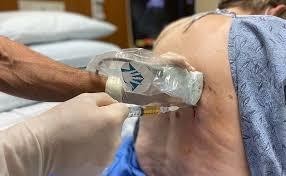The nurse is caring for a client after a thoracentesis that drained 50 mL of clear fluid from the left lung. Which assessment finding should the nurse report to the healthcare provider immediately?
Dullness bilaterally on percussion.
Serosanguinous drainage from the chest tube.
Diminished breath sounds in the left lower lobe.
Mediastinal shift to the right.
The Correct Answer is D
A) Incorrect- Dullness bilaterally on percussion is not a normal finding, but it is not an immediate concern after thoracentesis. It may indicate fluid accumulation or consolidation in both lungs, which could be related to other conditions such as pneumonia or heart failure.
B) Incorrect- Serosanguinous drainage from the chest tube is expected after thoracentesis, as long as it is not excessive or continuous. The nurse should monitor the amount and color of the drainage and document it accordingly.
C) Incorrect- Diminished breath sounds in the left lower lobe are also expected after thoracentesis, as the procedure removes fluid and air from the pleural space and reduces lung expansion. The nurse should auscultate the lungs before and after the procedure and compare the findings. The breath sounds should improve gradually as the lung re-expands.
D) Correct- This is a sign of tension pneumothorax, which is a life-threatening complication of thoracentesis. Tension pneumothorax occurs when air accumulates in the pleural space and creates positive pressure that pushes the mediastinum (the heart, great vessels, and trachea) to the opposite side of the chest. This can impair venous return, cardiac output, and respiratory function. The nurse should report this finding to the healthcare provider immediately and prepare to assist with needle decompression or chest tube insertion.

Nursing Test Bank
Naxlex Comprehensive Predictor Exams
Related Questions
Correct Answer is C
Explanation
A) Incorrect - Developing new screening protocols is important, but it doesn't directly indicate that the program has prevented diseases. Screening protocols might catch diseases but don't prevent them.
B) Incorrect - Clients receiving rehabilitation indicates they already had disease complications, which is not a primary prevention outcome.
C) Correct- An improvement in average client scores on risk factor knowledge tests suggests that the primary prevention program has successfully educated clients about behaviors and practices that can help prevent sexually transmitted diseases. This improvement indicates that clients have a better understanding of the risks and protective measures, which is a key indicator of program effectiveness.
D) Incorrect - Diagnosing clients early in their disease process is related to early detection (secondary prevention), not primary prevention.
Correct Answer is D
Explanation
A pounding headache in a client with COPD may be a symptom of increased carbon dioxide (CO2) levels in the blood, known as hypercapnia. Hypercapnia can lead to vasodilation, resulting in headaches. In this situation, it is crucial to assess the client's blood pressure to determine if it is elevated, as this could be contributing to the headache.
Obtaining a manual blood pressure measurement allows for a more accurate assessment of the client's blood pressure compared to automated measurements. It is important to assess both systolic and diastolic blood pressures, as elevated blood pressure can worsen headaches and have other negative effects on the client's health.
Elevating the head of the bed no higher than 30 degrees is a general measure used to improve respiratory function in clients with COPD. However, in this specific situation, it may not directly address the pounding headache. Elevating the head of the bed can help reduce dyspnea and improve oxygenation, but it may not alleviate the headache caused by hypercapnia.
Affirming blood glucose levels are below 160 mg/dL (8.88 mmol/L) is not the primary concern in this case. While high blood glucose levels can have various effects on the body, including headaches, the priority is to assess the client's blood pressure due to the specific context of a COPD exacerbation.
Checking for a stat intravenous diuretic prescription is not necessary in response to the client's headache. Diuretics are typically used to remove excess fluid from the body and may not directly address the underlying cause of the headache in this situation.

Whether you are a student looking to ace your exams or a practicing nurse seeking to enhance your expertise , our nursing education contents will empower you with the confidence and competence to make a difference in the lives of patients and become a respected leader in the healthcare field.
Visit Naxlex, invest in your future and unlock endless possibilities with our unparalleled nursing education contents today
Report Wrong Answer on the Current Question
Do you disagree with the answer? If yes, what is your expected answer? Explain.
Kindly be descriptive with the issue you are facing.
